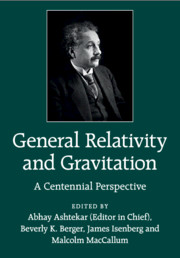Book contents
- Frontmatter
- Contents
- Preface
- List of contributors
- List of figures
- List of tables
- Part One Einstein's Triumph
- Part Two New Window on the Universe: Gravitational Waves
- Part Three Gravity is Geometry, after all
- 7 Probing Strong-Field Gravity Through Numerical Simulations
- 8 Initial Data and the Einstein Constraint Equations
- 9 Global Behavior of Solutions to Einstein's Equations
- Part Four Beyond Einstein
- Index
- References
7 - Probing Strong-Field Gravity Through Numerical Simulations
from Part Three - Gravity is Geometry, after all
Published online by Cambridge University Press: 05 June 2015
- Frontmatter
- Contents
- Preface
- List of contributors
- List of figures
- List of tables
- Part One Einstein's Triumph
- Part Two New Window on the Universe: Gravitational Waves
- Part Three Gravity is Geometry, after all
- 7 Probing Strong-Field Gravity Through Numerical Simulations
- 8 Initial Data and the Einstein Constraint Equations
- 9 Global Behavior of Solutions to Einstein's Equations
- Part Four Beyond Einstein
- Index
- References
Summary
This chapter describes what has been learned about the dynamical, strong-field regime of general relativity via numerical methods. There is no rigorous way to identify this regime, in particular since notions of energies, velocities, length and timescales are observer- dependent at best, and at worst are not well-defined locally or even globally. Loosely speaking, however, dynamical strong-field phenomena exhibit the following properties: there is at least one region of spacetime of characteristic size R containing energy E where the compactness 2GE/(c4R) approaches unity, local velocities approach the speed of light c, and luminosities (of gravitational or matter fields) can approach the Planck luminosity c5 /G. A less physical characterization, though one better suited to classifying solutions, involves spacetimes where even in “well-adapted” coordinates the non-linearities of the field equations are strongly manifest. In many of the cases where these conditions are met, numerical methods are the only option available to solve the Einstein field equations, and such scenarios are the subject of this chapter.
Mirroring trends in the growth and efficacy of computation, numerical solutions have had greatest impact on the field in the decades following the 1987 volume [1] celebrating the 300th anniversary of Newton's Principia. However, several pioneering studies laying the foundation for subsequent advances were undertaken before this, and they are briefly reviewed in Section 7.1 below. Though this review focuses on the physics that has been gleaned from computational solutions, there are some unique challenges in numerical evolution of the Einstein equations; these as well as the basic computational strategies that are currently dominant in numerical relativity are discussed in Section 7.2. As important as computational science has become in uncovering details of solutions too complex to model analytically, it is a rare moment when qualitatively new physics is uncovered. The standout example in general relativity is the discovery of critical phenomena in gravitation collapse (Section 7.3.1); another noteworthy example is the formation of so-called spikes in the approach to cosmological singularities (Section 7.3.7).
- Type
- Chapter
- Information
- General Relativity and GravitationA Centennial Perspective, pp. 361 - 411Publisher: Cambridge University PressPrint publication year: 2015
References
- 11
- Cited by

